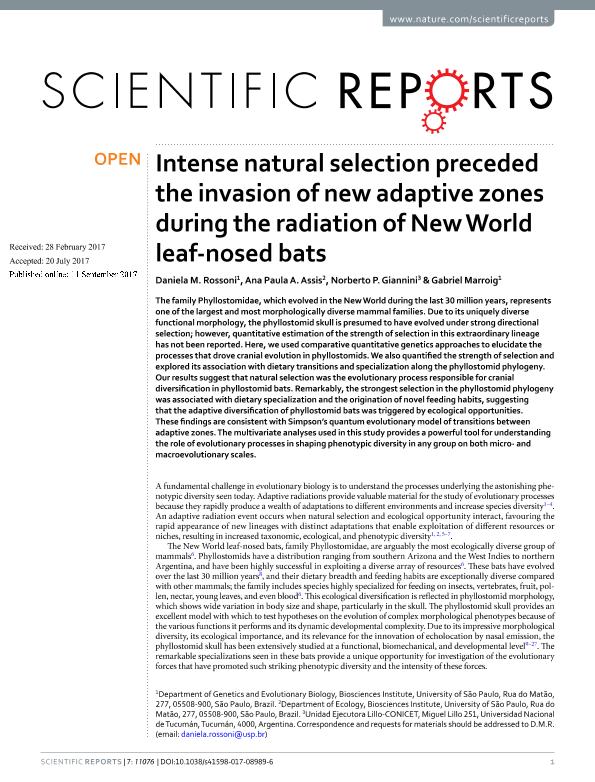Mostrar el registro sencillo del ítem
dc.contributor.author
Rossoni, Daniela M.
dc.contributor.author
Assis, Ana Paula A.
dc.contributor.author
Giannini, Norberto Pedro

dc.contributor.author
Marroig, Gabriel
dc.date.available
2018-09-28T19:35:15Z
dc.date.issued
2017-12
dc.identifier.citation
Rossoni, Daniela M.; Assis, Ana Paula A.; Giannini, Norberto Pedro; Marroig, Gabriel; Intense natural selection preceded the invasion of new adaptive zones during the radiation of New World leaf-nosed bats; Nature Publishing Group; Scientific Reports; 7; 1; 12-2017; 1-11
dc.identifier.issn
2045-2322
dc.identifier.uri
http://hdl.handle.net/11336/61298
dc.description.abstract
The family Phyllostomidae, which evolved in the New World during the last 30 million years, represents one of the largest and most morphologically diverse mammal families. Due to its uniquely diverse functional morphology, the phyllostomid skull is presumed to have evolved under strong directional selection; however, quantitative estimation of the strength of selection in this extraordinary lineage has not been reported. Here, we used comparative quantitative genetics approaches to elucidate the processes that drove cranial evolution in phyllostomids. We also quantified the strength of selection and explored its association with dietary transitions and specialization along the phyllostomid phylogeny. Our results suggest that natural selection was the evolutionary process responsible for cranial diversification in phyllostomid bats. Remarkably, the strongest selection in the phyllostomid phylogeny was associated with dietary specialization and the origination of novel feeding habits, suggesting that the adaptive diversification of phyllostomid bats was triggered by ecological opportunities. These findings are consistent with Simpson's quantum evolutionary model of transitions between adaptive zones. The multivariate analyses used in this study provides a powerful tool for understanding the role of evolutionary processes in shaping phenotypic diversity in any group on both micro- and macroevolutionary scales.
dc.format
application/pdf
dc.language.iso
eng
dc.publisher
Nature Publishing Group
dc.rights
info:eu-repo/semantics/openAccess
dc.rights.uri
https://creativecommons.org/licenses/by-nc-sa/2.5/ar/
dc.subject
Phyllostomidae
dc.subject
Mammal Families
dc.subject
Functional Morphology
dc.subject
Strength of Selection
dc.subject.classification
Otras Ciencias Biológicas

dc.subject.classification
Ciencias Biológicas

dc.subject.classification
CIENCIAS NATURALES Y EXACTAS

dc.title
Intense natural selection preceded the invasion of new adaptive zones during the radiation of New World leaf-nosed bats
dc.type
info:eu-repo/semantics/article
dc.type
info:ar-repo/semantics/artículo
dc.type
info:eu-repo/semantics/publishedVersion
dc.date.updated
2018-08-30T13:32:06Z
dc.journal.volume
7
dc.journal.number
1
dc.journal.pagination
1-11
dc.journal.pais
Reino Unido

dc.journal.ciudad
Londres
dc.description.fil
Fil: Rossoni, Daniela M.. Universidade de Sao Paulo; Brasil
dc.description.fil
Fil: Assis, Ana Paula A.. Universidade de Sao Paulo; Brasil
dc.description.fil
Fil: Giannini, Norberto Pedro. Consejo Nacional de Investigaciones Científicas y Técnicas. Centro Científico Tecnológico - Tucumán. Unidad Ejecutora Lillo; Argentina
dc.description.fil
Fil: Marroig, Gabriel. Universidade de Sao Paulo; Brasil
dc.journal.title
Scientific Reports
dc.relation.alternativeid
info:eu-repo/semantics/altIdentifier/url/http://www.nature.com/articles/s41598-017-08989-6
dc.relation.alternativeid
info:eu-repo/semantics/altIdentifier/doi/https://dx.doi.org/10.1038/s41598-017-08989-6
Archivos asociados
